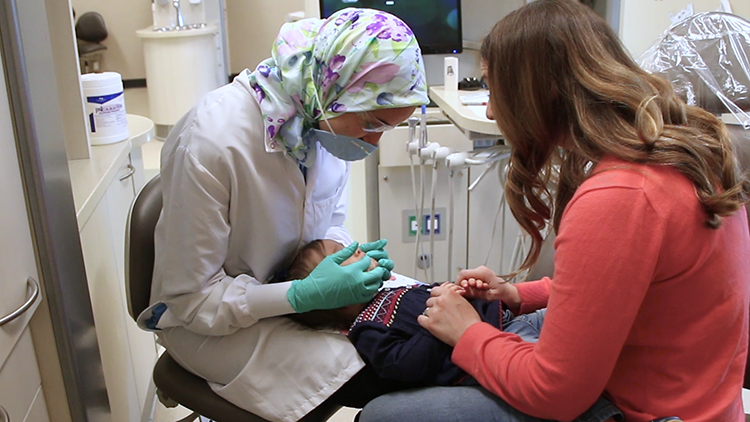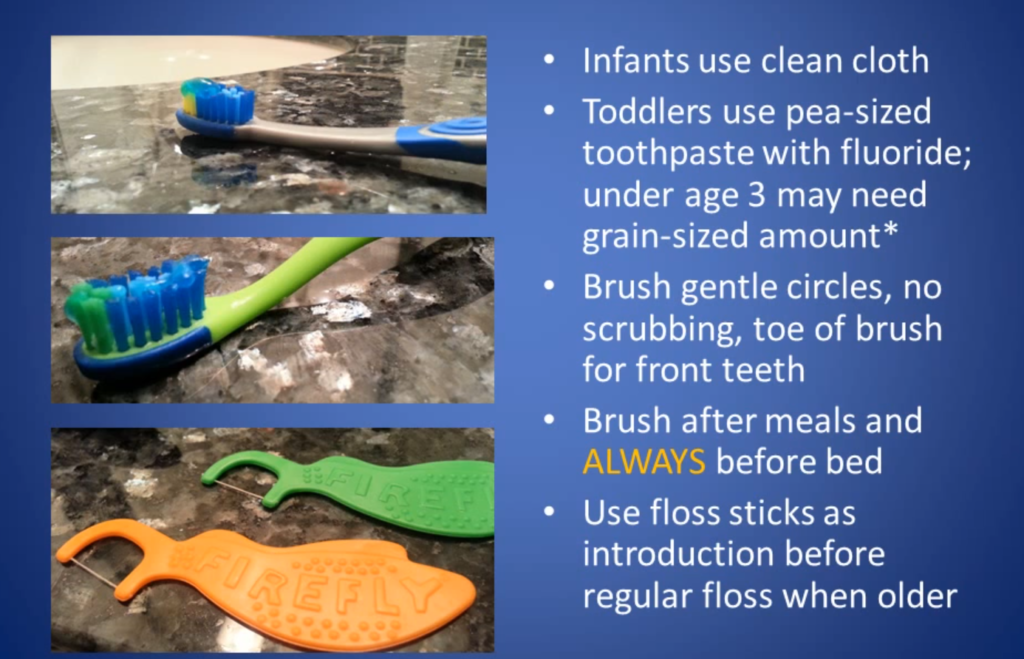As parents, we strive to provide our children with the best start in life, and that includes instilling good oral hygiene habits from an early age. Proper brushing and flossing techniques are essential for maintaining healthy teeth and gums. In this blog post, we will explore some valuable tips and strategies to make brushing and flossing a positive and enjoyable experience for infants and children.
Brushing and flossing plays an important role in preventing tooth decay and gingivitis, and we want to start doing so as early as possible.
Infants and young kids lack the dexterity to brush for themselves. It’s important to continue helping them to brush, even past age six or seven, when the child does want to get involved. Though it’s very important to allow them to brush, always be sure to finish for them afterwards.
Brushing Technique

The head in lap technique that you see pictured in this photo gives you the best view, if the child is a little bit less cooperative.
The second parent can be sitting at the knees of the child to sing songs to distract the child or just to help hold the child down. This gives you the best view and allows you to be able to brush as best as possible for your child, rather than being on the countertop or on the bed. It’s also a little bit easier on your back.
When brushing, it’s best to use gentle circles without scrubbing. When you get to the front of the teeth, you want to use the toe of the brush to be able to get into those areas a little bit better. The best time to brush is after meals and before bed.
Once more teeth arrive and start to touch, using floss sticks serves as a great introduction to flossing for your child, before they’re a little bit older and have the dexterity to use regular floss. Floss sticks make it easier to maneuver between their teeth. Guide them gently and demonstrate how to floss effectively, emphasizing the importance of removing food particles and plaque from hard-to-reach areas.
The Importance and Use of Fluoride
Fluoride is very important in helping prevent tooth decay. The water in the Greater Vancouver area is not fluoridated, other than naturally occurring fluoride. Health-wise, there are no ill effects from consuming the amount of fluoride in public drinking water.
An excess or over consumption of fluoride, however, can lead to a condition called fluorosis, which can cause discoloration of our developing teeth. Despite aesthetic issues, this is not a concern health-wise.
Fluoride is very important in preventing decay for a number of reasons:
- It helps reduce the bacterial load in our mouth.
- It strengthens the enamel and makes it a little bit more resistant to the acid attacks caused by bacteria
That’s why we always recommend the use of a toothpaste with fluoride.
Upon visiting your dentist on a regular basis, the dentist may recommend supplemental or extra topical fluoride be given to your child based on an examination and assessment of their diet and level of risk of tooth decay.
When To Start Using Fluoride
For infants, before the teeth have arrived, you can use a clean cloth just to wipe the gum tissue after a feeding. Once the first tooth arrives you can start using a toothbrush and toothpaste with fluoride. It’s recommended by the BC Dental Association and the Canadian Dental Association that a smear the size of a grain of rice of fluoridated toothpaste be used for children under the age of 3. That small amount can be swallowed without any concern. If your child is over the age of 3 AND is able to spit out the toothpaste after brushing, then you can use a pea-sized amount as shown in the topmost image below.

By following these brushing and flossing tips for infants and children, you can help promote excellent oral hygiene practices and set the foundation for a lifetime of healthy smiles. Remember, consistency and parental guidance are key. With a little creativity, patience, and a positive approach, you can make brushing and flossing an enjoyable part of your child’s daily routine. Start early, lead by example, and prioritize regular dental visits to ensure your child’s oral health remains strong and vibrant. Happy brushing and flossing!
Contact us to book an appointment today or to learn more!
Additional Resource Links

